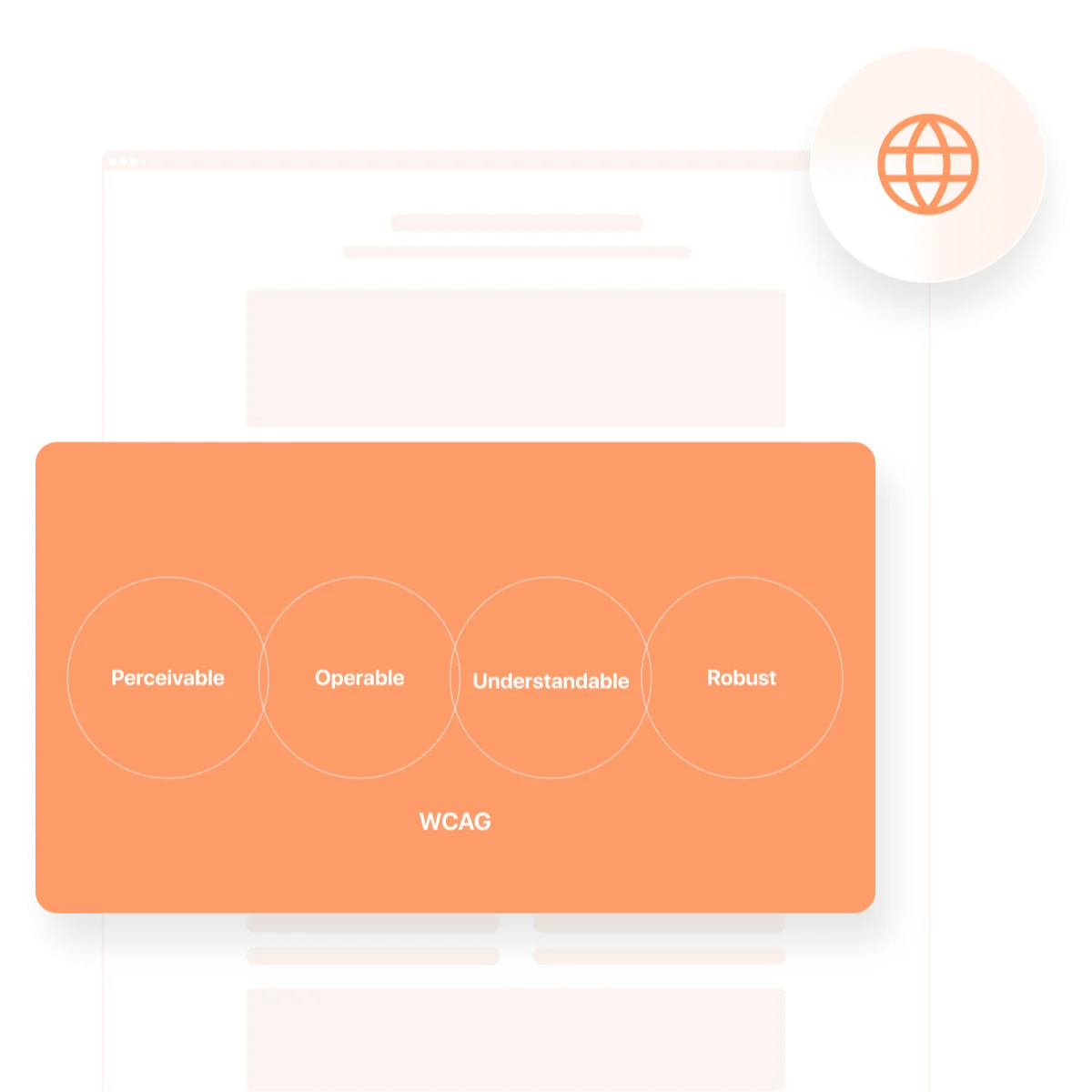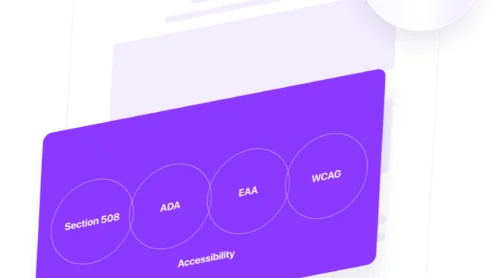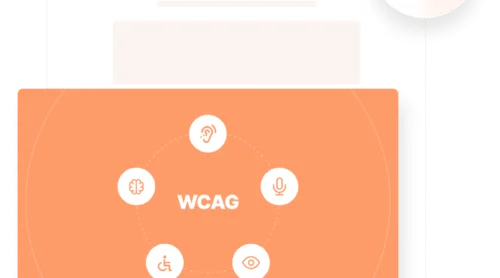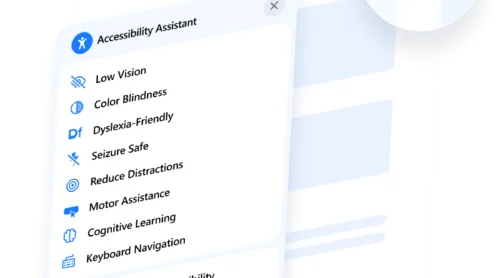WCAG stands for Web Content Accessibility Guidelines — a set of international recommendations developed by the World Wide Web Consortium (W3C). These guidelines are designed to make digital content more accessible to people with various disabilities, including visual, auditory, cognitive, and motor impairments.
At their core, WCAG web accessibility guidelines provide a framework for building inclusive, user-friendly experiences that empower everyone to navigate and interact with digital content. They are recognized globally as the gold standard for web accessibility requirements, helping developers, designers, and business owners ensure equal access to information.
The guidelines aim to bridge the digital divide by encouraging digital inclusion practices and fostering a more disability-friendly web experience. Whether you’re publishing a blog or managing an ecommerce platform, adhering to these principles reflects a commitment to following digital ethics while also reducing legal risks.
By understanding what WCAG guidelines are and who they serve, you take the first step toward improving usability, expanding your audience, and strengthening trust in your brand.
Understanding the WCAG Standards
The WCAG standards serve as the cornerstone of digital accessibility, providing a framework for developers and content creators to ensure their websites are usable by everyone — including individuals with disabilities. Created by the W3C’s Web Accessibility Initiative (WAI), these standards outline a detailed structure of guidelines, success criteria, and conformance levels that can be applied to various types of web content and functionality.
To begin, WCAG is organized into four fundamental pillars known as the POUR principles: Perceivable, Operable, Understandable, and Robust. These concepts help website creators think more holistically about how users interact with content, especially when they rely on assistive technologies like screen readers or keyboard navigation.
- Perceivable. Ensure content is available to users through different sensory channels (text alternatives, captions, adaptable layouts).
- Operable. Make all interactive components functional via multiple input methods (keyboard, voice, etc.).
- Understandable. Keep content predictable, readable, and easy to use (clear forms, consistent navigation, helpful error messages).
- Robust. Build content that works across platforms and is compatible with assistive technology updates.
Here’s a simplified view of what some of the WCAG requirements might look like in practice:
| Principle | Guideline | Example Requirement (Success Criterion) | Level |
|---|---|---|---|
| Perceivable | Text Alternatives | Provide alt text for all non-text content | A |
| Operable | Keyboard Accessible | Ensure all functionality is usable via keyboard | A |
| Understandable | Input Assistance | Label form fields clearly and give instructions | AA |
| Robust | Compatible | Use clean HTML that works well with assistive technologies | AA |
The WCAG guidelines themselves are divided into versions — such as WCAG 2.0, 2.1, and the upcoming 2.2 — each expanding on the core standards. Within each version, the structure is further broken down into:
- Guidelines — Broad objectives under each POUR category.
- Success Criteria — Testable statements that determine if a requirement has been met.
- Conformance Levels — A (basic), AA (standard), and AAA (enhanced) compliance tiers.
Conforming to these standards doesn’t only improve accessibility—it also boosts the overall user experience, regardless of ability. Developers often use a compliance checking tool to streamline audits, automate fixes, and ensure they’re meeting specific success criteria.
Understanding and applying the WCAG principles and guidelines is critical for enhancing readability and navigation, creating accessible experiences, and achieving inclusive interface design. Whether you’re developing a new layout or refining an existing one, aligning with WCAG helps ensure your digital content is available and useful to all users — today and in the future.
WCAG 2.1 vs WCAG 2.2
The evolution of WCAG standards reflects the ongoing efforts of the W3C to adapt to technological shifts and user needs. Since WCAG 2.0 was published in 2008, both versions 2.1 and 2.2 have introduced essential changes aimed at making web content even more inclusive. If you’re aiming for up-to-date compliance, it’s crucial to understand the differences between these versions and what they mean for your usability benchmarks.
WCAG 2.1 accessibility requirements were released in June 2018 as an official update to WCAG 2.0. While it retained the same structure and principles, it introduced 17 new success criteria to better support users with low vision, cognitive limitations, and those navigating via mobile devices.
In contrast, WCAG 2.2 adds 9 more success criteria on top of 2.1. These reflect the industry’s evolving compliance expectations by focusing more deeply on usability and inclusive interaction.
Key Differences Between WCAG 2.1 and 2.2
- WCAG 2.1: Introduced 17 new criteria, bringing the total to 78.
- WCAG 2.2: Adds 9 more criteria, resulting in 87 total guidelines.
- Focus Areas in 2.1: Mobile navigation, orientation, zoom functions, and improved readability.
- Focus Areas in 2.2: Better support for cognitive disabilities, simplified user input, and easier control mechanisms.
So, how many WCAG guidelines are there in total? As of version 2.1, there are 78 testable success criteria. With 2.2, this will grow to 87, further expanding the scope of what accessibility entails. This level of detail shows how digital accessibility updates are never static — they evolve as user behavior and technology change.
While keeping up may seem challenging, tools like an accessibility compliance widget can help track changes, apply necessary updates, and meet newer requirements without overhauling your entire design. Staying current with the new WCAG guidelines positions your website for broader reach and lasting accessibility.
Design Guidelines and Visual Standards
Design plays a major role in accessibility — and WCAG design guidelines provide clear direction for ensuring that your visual choices serve all users. From font size to contrast ratios, these standards help designers build inclusive interface designs that go beyond aesthetics and directly impact usability.
According to WCAG font guidelines, designers must avoid overly decorative typefaces, maintain consistent alignment, and use sufficient spacing between characters and lines to support enhancing readability and navigation. But one of the most overlooked issues is font size.
WCAG font size guidelines recommend using a minimum of 16px for body text to accommodate users with low vision or reading challenges. Text should also be scalable up to 200% without loss of functionality or content, which allows users to adjust content based on their needs.
Color and contrast are equally critical. Text and background colors must meet a minimum contrast ratio of:
- 4.5:1 for normal text (below 18px)
- 3:1 for large text (18px and above)
Designers should also avoid flashing content, use clear visual focus states for interactive elements, and maintain consistency across layouts. All of these factors contribute to creating accessible experiences that lets users adjust visual settings in real time.
How to Meet WCAG Requirements
Achieving WCAG compliance is not a one-time task — it’s an ongoing process rooted in thoughtful planning, execution, and maintenance. Whether you’re launching a new platform or optimizing an existing one, aligning with web accessibility is essential for meeting legal obligations and expanding your reach.
Here’s a step-by-step breakdown of how to meet WCAG compliance requirements effectively:
- Review the Guidelines. Familiarize yourself with the WCAG compliance guidelines (Level A, AA, or AAA), and identify which level aligns with your goals or legal obligations.
- Perform an Accessibility Audit. Use automated and manual methods to detect issues. Consider tools like screen readers, keyboard navigation checks, and contrast analyzers.
- Fix Critical Barriers. Address high-impact issues first — such as missing alt text, low contrast, or broken navigation structures.
- Test with Real Users. Involve individuals with disabilities in usability testing to identify gaps that automated tests might miss.
- Implement Assistive Tools. Add an accessibility widget to give users control over contrast, font size, and navigation preferences.
- Document and Maintain. Keep a record of compliance actions and set up a regular review schedule to stay aligned with WCAG accessibility requirements.
Maintaining accessibility isn’t just about checklists — it’s about creating inclusive experiences that welcome every visitor. Regular compliance audits for accessibility help ensure your website adapts as guidelines evolve and technologies shift. By investing in the right tools and strategies, your team can stay ahead of legal risks and deliver a seamless experience to all users.
Make WCAG Compliance Easy With Elfsight
If you’re looking for a fast, effective way to meet WCAG requirements, the Elfsight accessibility widget offers a seamless solution — no coding or technical skills required. Designed to help you comply with both WCAG, ADA, and EAA guidelines, this tool empowers users to personalize their experience while helping you fulfill your accessibility obligations.
The widget includes preset accessibility modes for users with diverse needs — such as low vision, dyslexia, epilepsy sensitivity, and color blindness — ensuring everyone can comfortably navigate your content. With just a few clicks, visitors can adjust visuals, interaction patterns, and language settings.
How to Get Started with the Widget:
- Pick a template. Open the Elfsight editor and choose from professional accessibility presets. Click “Continue with this template” to start.
- Scan your website. Use the built-in audit tool to detect accessibility issues based on WCAG standards.
- Customize settings. Define widget placement, language, display devices, memory preferences, and more. Add custom CSS or JavaScript if needed.
- Install the widget. Click “Add to website for free”, copy the embed code, and paste it into your HTML or CMS.
Why Choose Elfsight for Accessibility?
With usability and flexibility in mind, the widget offers everything you need to ensure long-term accessibility. Whether you’re just getting started or refining your compliance strategy, these key features make Elfsight an excellent companion for your accessibility journey:
- Accessibility presets. Quick-activate modes like Dyslexia-Friendly, Epilepsy Safe, and Low Vision.
- Design control. Tweak icons, colors, widget position, and visibility for a consistent look.
- WCAG-based audit. Identify gaps before users even encounter them.
- Preference memory. Automatically saves user settings for future visits.
- Multilingual. Choose from 20+ languages or upload your own translations.
With the Elfsight accessibility widget, you’ll not only meet standards — you’ll actively create a space that adapts to your users. It’s a smart, scalable way to promote inclusion and boost usability across the board.
Ready to create an inclusive experience for every visitor? Try the widget now!
WCAG and Other Accessibility Guidelines
While WCAG is the most widely adopted technical framework, it operates within a larger ecosystem of content accessibility guidelines and legal standards.
The relationship between WCAG and W3C accessibility standards is foundational — W3C is the governing body that defines the technical specifications, while WCAG provides the detailed structure to ensure those specifications meet real-world accessibility needs. Around the world, governments and institutions reference WCAG when crafting accessibility legislation.
How WCAG Aligns With Global Accessibility Laws
| Standard or Law | Region | Legally Required? | Entities Affected | Primary Focus | Enforcement Details |
|---|---|---|---|---|---|
| WCAG (Web Content Accessibility Guidelines) | Global | No (but referenced by many laws) | Public and private websites | Technical accessibility standards | Voluntary unless mandated by local laws |
| ADA (Americans with Disabilities Act) | United States | Yes | Businesses, schools, hospitals, government agencies | Equal access for users with disabilities | Enforced through litigation and DOJ actions |
| Section 508 | United States (Federal Agencies) | Yes | Federal websites and electronic content | Accessible ICT for government employees and citizens | Audits, procurement requirements, agency accountability |
| EAA (European Accessibility Act) | European Union | Yes (effective June 2025) | Private businesses offering digital products/services | Accessibility across ecommerce, banking, media, etc. | National enforcement bodies + consumer complaints |
So, is WCAG a legal requirement? Technically, WCAG itself is not law — but it is the standard cited by nearly all major accessibility legislation. This means WCAG compliance is required to avoid legal risk and fulfill international accessibility laws.
Incorporating web accessibility standards into your strategy is about more than checking boxes — it’s about honoring digital ethics and meeting usability benchmarks that enhance the experience for every user. To streamline the process, many organizations turn to a dependable compliance tool to support both technical and legal adherence.
Final Thoughts
Adopting WCAG guidelines for accessibility is more than a regulatory box to check — it’s a strategic decision that supports growth, innovation, and inclusion. As the digital world continues to evolve, organizations that embed compliance principles into their design and development workflows will be better positioned to serve all users, regardless of ability or context.
Creating an inclusive experience benefits everyone. From improved SEO and usability to broader audience reach and brand trust, accessible design is simply good design. Whether you’re launching a new product, redesigning a platform, or just refining content, embracing digital inclusion practices is a future-ready mindset.







